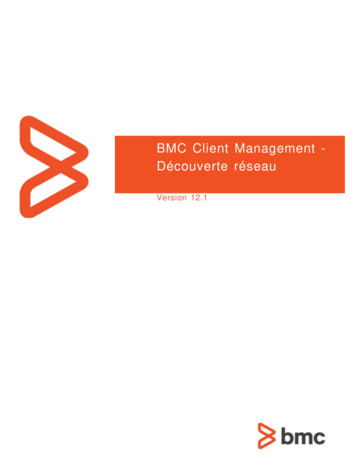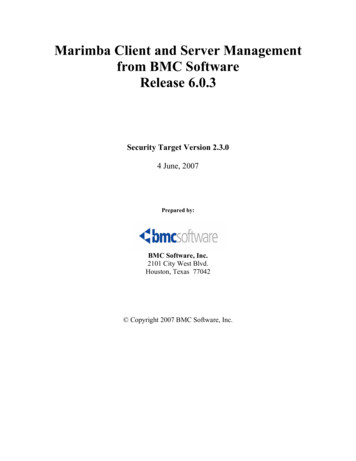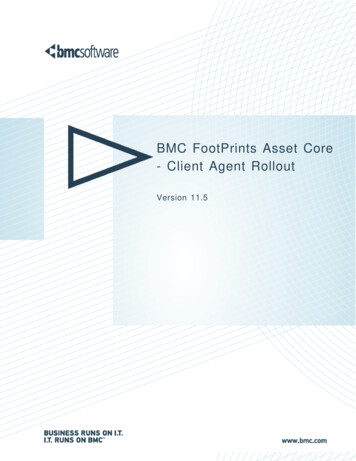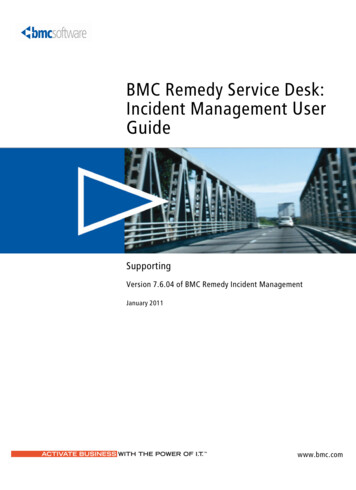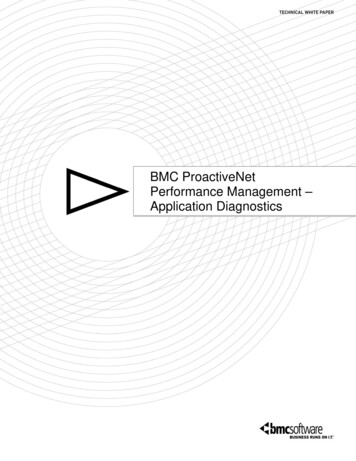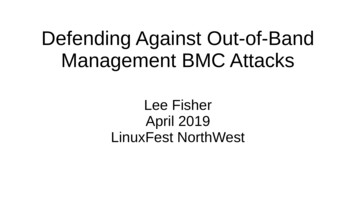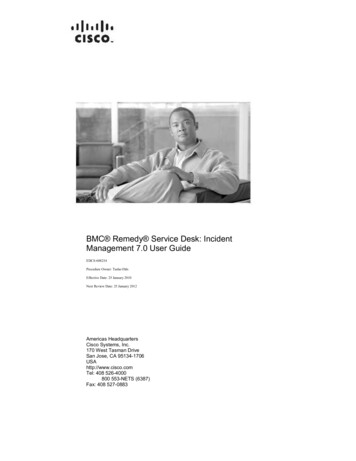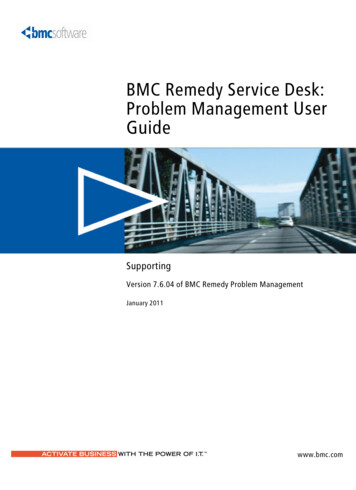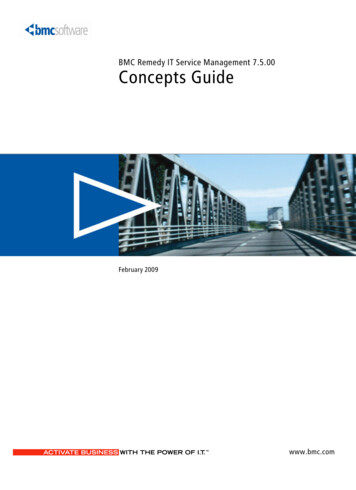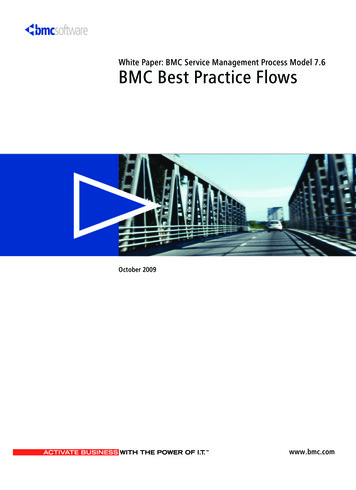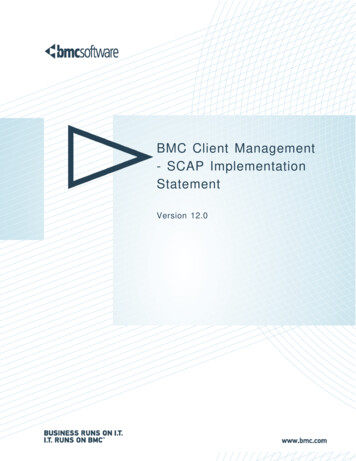
Transcription
BMC Client Management- SCAP ImplementationStatementVersion 12.0
BMC Client Management - SCAP Implementation Statement TOC 3ContentsSCAP Implementation Statement. 4
4 BMC Client Management - SCAP Implementation Statement SCAP Implementation StatementSCAP Implementation StatementThe SCAP features in BMC Client Management comply with the Technical Specification for the Security ContentAutomation Protocol (SCAP): Version 1.2. Using features in the BMC Client Management Console, you import SCAP contentfrom third-party sources, such as the NIST NVD National Checklist Program repository. Results are generated as XML filescompliant with both the SCAP (for ARF) and XCCDF specifications.BMC Software, Inc. asserts that BMC Client Management (BCM) version 12.00.00 meets or exceeds the Derived TestRequirements (DTR) for SCAP 1.0, 1.1 and 1.2 as described in NIST IR 7511 Revision 3 for the following SCAP capabilitiesand supported platform family:Capabilities Authenticated Configuration ScannerCommon Vulnerabilities and Exposures (CVE) OptionPlatform Families Microsoft Windows 7, 64 bitMicrosoft Windows 7, 32 bitMicrosoft Windows Vista, SP2Microsoft Windows XP Pro, SP3Red Hat Enterprise Linux 5 Desktop, 64 bitRed Hat Enterprise Linux 5 Desktop, 32 bitBMC Client Management additionally provides SCAP capabilities for systems such as MAC OS X and other Windows/Linuxflavors, but these are not certified.SCAP 1.2 ConformanceBMC Client Management conforms to the specifications of the Security Content Automation Protocol, version 1.2 (SCAP1.2), as outlined in NIST Special Publication (SP) 800-126 rev 2. As part of the SCAP 1.2 protocol, BMC Client Managementassessment capabilities have been expanded to include the consumption of source data stream collection XML files andthe generation of well-formed SCAP result data streams.To exercise this capability, users may download the SCAP 1.2 content from the NIST NVD National Checklist Programrepository, or any other source of SCAP 1.2 compliant content, and perform assessments in a similar manner as with BMCClient Management custom compliance.The BMC Client Management implementation includes the following components: Extensible Configuration Checklist Description Format (XCCDF) 1.2, a language for authoring security checklists/benchmarks and for reporting results of evaluating them.Open Vulnerability and Assessment Language (OVAL) 5.10.1, a language for representing system configurationinformation, assessing machine state, and reporting assessment results.Asset Reporting Format (ARF) 1.1, a format for expressing the transport format of information about assets and therelationships between assets and reports.Asset Identification 1.1, a format for uniquely identifying assets based on known identifiers and/or known informationabout the assets.Common Platform Enumeration (CPE) 2.3, a nomenclature and dictionary of hardware, operating systems, andapplications.Common Configuration Enumeration (CCE) 5, a nomenclature and dictionary of software security configurations.Common Vulnerabilities and Exposures (CVE), a nomenclature and dictionary of security-related software flaws.Common Vulnerability Scoring System (CVSS) 2.0, a system for measuring the relative severity of software flawvulnerabilities.Numara Software, Inc. and BMC Software, Inc. Confidential.
BMC Client Management - SCAP Implementation Statement SCAP Implementation Statement 5 Common Configuration Scoring System (CCSS) 1.0, a system for measuring the relative severity of system securityconfiguration issues. BMC Client Management supports CCSS scores when that score is used in the @weight attributewithin XCCDF rules.Trust Model for Security Automation Data (TMSAD) 1.0, a specification for using digital signatures in a common trustmodel applied to other security automation specifications. BMC Client Management can import SCAP content withTrust Model for Security Automation Data (TMSAD) signatures but will not verify them. The generated XML report willnot include TMSAD signatures.SCAP 1.0 CompatibilityBMC Client Management natively supports the older SCAP 1.0 specification, including: Extensible Configuration Checklist Description Format (XCCDF) version 1.1.4Open Vulnerability and Assessment Language (OVAL), version 5.3 and 5.4Common Configuration Enumeration (CCE) version 5Common Platform Enumeration (CPE) version 2.2The Common Vulnerabilities and Exposures (CVE)Common Vulnerability Scoring System (CVSS) version 2.0SCAP 1.1 CompatibilityBMC Client Management natively supports the older SCAP 1.1 specification, including: Extensible Configuration Checklist Description Format (XCCDF) version 1.1.4Open Vulnerability and Assessment Language (OVAL) version 5.8Common Configuration Enumeration (CCE) version 5Common Platform Enumeration (CPE) version 2.2Common Vulnerabilities and Exposures (CVE)Common Vulnerability Scoring System (CVSS) version 2.0CVE and CCE listsBMC Client Management allows to import CVE and CCE lists. Both of these lists are part of the six existing open standardsused by NIST in its Security Content Automation Protocol (SCAP) program. They help, through the use of consistentidentifiers, to improve data correlation; enable interoperability; foster automation; and ease the gathering of metrics foruse in situation awareness, IT security audits, and regulatory compliance. CVE provides this capability for informationsecurity vulnerabilities, CCE assigns a unique, common identifier to a particular security-related configuration issue: CVE (Common Vulnerabilities and Exposures) is a dictionary of common names (that is, CVE Identifiers) for publiclyknown information security vulnerabilities. CVE is now the industry standard for vulnerability and exposure names.CVE Identifiers provide reference points for data exchange so that information security products and services canspeak with each other.CCE (Common configuration Enumeration) lists provide unique identifiers to security-related system configurationissues in order to improve workflow by facilitating fast and accurate correlation of configuration data across multipleinformation sources and tools.Numara Software, Inc. and BMC Software, Inc. Confidential.
BMC Client Management additionally provides SCAP capabilities for systems such as MAC OS X and other Windows/Linux flavors, but these are not certified. SCAP 1.2 Conformance BMC Client Management
